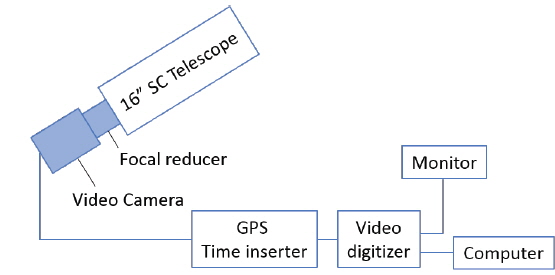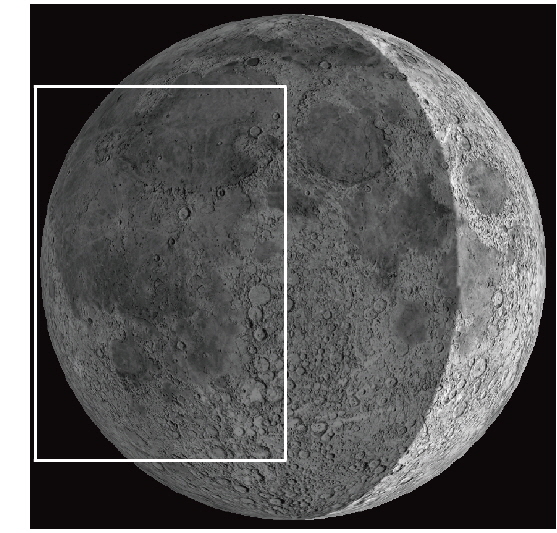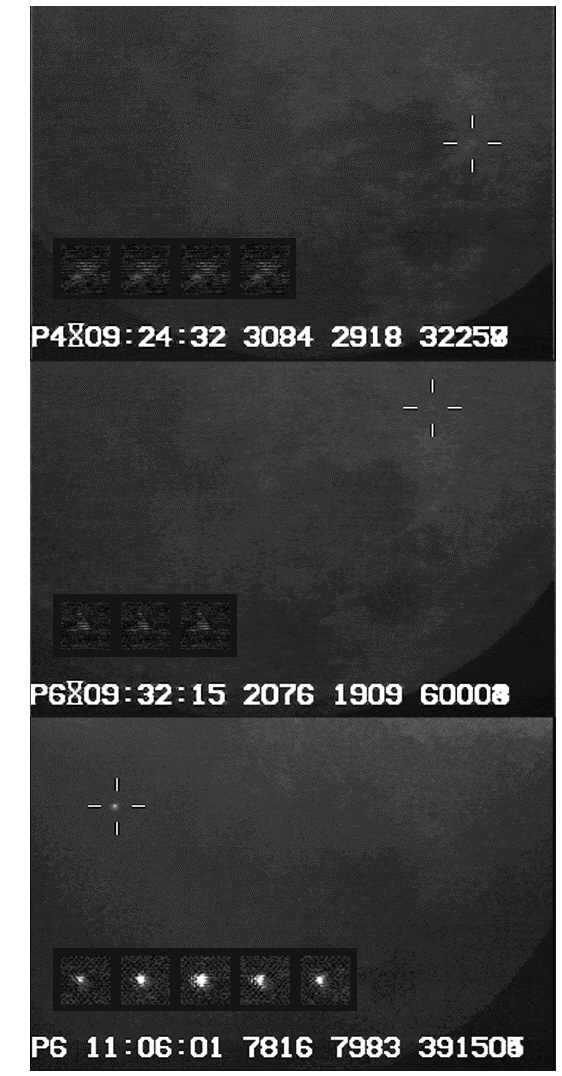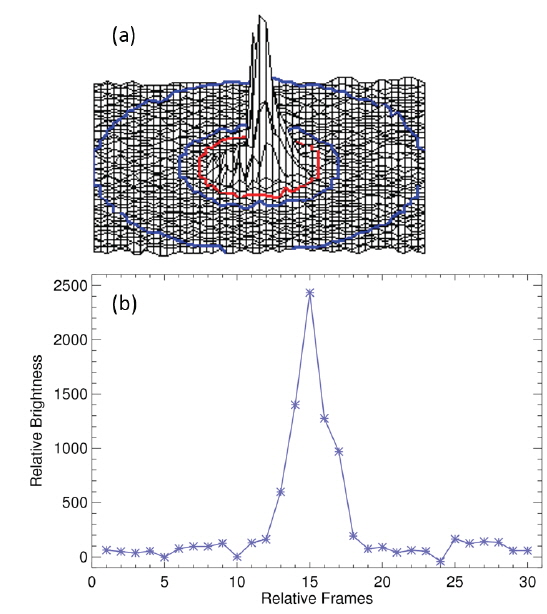



When a meteoroid collides with the Moon, a transient luminous event called a impact flash occurs. Meteoroid impacts are reported to have caused about one fifth of the lunar seismic events recorded by the Apollo passive seismic experiment between 1969 and 1977 (Nakamura et al. 1981; Lognonne et al. 2009). Seismic records are essential to understand the crustal structure of the Moon, if they are analyzed together with specific parameters of the seismic source, such as location and magnitude. However, knowledge about these parameters can only be obtained from direct observation of an impact flash. Statistics on lunar impact flashes also contribute to characterizing the population of Earth-crossing meteoroids.
Video observation of a meteoroid impact flash on the Moon was first successful during the 1999 Leonid meteor storms (Dunham et al. 2000; Ortiz et al. 2000, 2002). Routine impact monitoring has been carried out with an automatic system at NASA Marshall Space Flight Center (MSFC) since 2006 (Cooke et al. 2007; Oberst et al. 2012). During the first five years they found a total of 240 impacts; on average one flash for every two hours of observation, with dramatically higher rates during meteor showers. Oberst et al. (2012) estimated a meteoroid impact flux of 1.34×10−7
Encouraged by such successful impact flash observations, the NASA Meteoroid Environment Office (NASA/MEO) promoted a worldwide impact monitoring campaign during the Lunar Atmosphere and Dust Environment Explorer (LADEE) mission, which launched on Sept. 7, 2013 and operated for a nominal period of 160 days (Suggs & Moser 2013). After setting up a video observation system for the 16-inch educational telescope at Chungnam National University, we participated in the monitoring campaign of lunar impact flashes from October, 2013 through April, 2014. Here, we report an impact flash candidate from our monitoring campaign. Lunar impact monitoring provides good educational merit because it can be carried out on campus with an educational telescope in the evening hours by a group of students. We herein describe our monitoring system and our first plausible detection of lunar impact flash in detail, hoping that other institutes and universities in Korea will join in lunar impact monitoring to enable simultaneous identification of impact flash for better scientific output in the future.
The lunar monitoring community has been utilizing small amateur telescopes (minimum diameter 14 inches) to detect faint impact flashes. It is desirable to be able to cover a large field of view (FOV), comparable to a half-moon. This can be achieved by attaching a focal reducer to amateur telescopes. We set up an impact monitoring system with our educational 16-inch Schmidt Cassegrain telescope (MEADE LX200) and f/3.3 focal reducer in front of a black-white sensitive video camera (Samsung SCB-4000). To detect sub-second flashes, the video camera records 30 frames per second with a millisecond accuracy time stamp from a GPS receiver (IOTA-VTI). The schematic diagram and specifications of modules are presented in Fig. 1 and Table 1, respectively.
[Table 1.] Video observation system at Chungnam National University

Video observation system at Chungnam National University
Since faint impact flashes cannot be detected against the illuminated part of the moon, one needs to orient the FOV of the observing system to include only the unilluminated part of the moon, and thus adequate observation can be done only during lunar phases less than ~ 50%. During the period between the first and third quarters, the moon is too bright to detect faint flashes even in the unilluminated part. It is also impractical to observe a less than 10% illuminated crescent moon, which is too close to both horizon and the sun. Thus, the practical observation period includes only early evenings of 5–6 days between new moon and first half moon, and early dawns of 5–6 days between third moon and old crescent. After focusing an image of the moon, we move the telescope to fit the rectangular FOV on the unilluminated part of the moon, as shown in Fig. 2. The FOV covers a rectangular area of 25.60′ by 18.70′ and each pixel of the video camera subtends 2.1″ by 2.3″ of the observed view. The video camera gain is adjusted to identify barely the limb of the moon against the background sky, but not to make the moon’s image too bright to detect faint flashes. The video camera records images in AVI format. This requires 72 GB storage per hour of observation.
Impact flashes are expected to be very faint and brief in the recorded video images, and thus hardly recognizable with naked eyes. We utilized a search program, LunarScan 1.53, provided by NASA/MEO (Gural 2007). The program scans video images to look for flashes that exceed by at least 3.5 times the standard deviation from the mean pixel values (Suggs et al. 2008). Impact flashes are usually indicated by a star-like pixel distribution with decaying brightness after a peak, whereas cosmic rays hitting CCD chips, thermal noise, brief sunlight reflection off a satellite, and other flash sources may produce a sudden and localized brightening in the image. These are often irregularly shaped, rather than point-spread shaped, but still may be falsely recognized as an impact flash. To be certain of an impact flash, simultaneous observations from two or more sites at least 10 km apart are desirable.
Selenographic longitudes and latitudes of impact flash candidates were found by overlapping the observed image with a map from the Virtual Moon Atlas (private comm. with C. Legrand). The relative brightness of a flash candidate was extracted from the observed image using an image processing program, LiMovie (by Kazuhisa Miyashita). The programs mentioned here are widely used in the lunar impact monitoring community, including NASA/MEO.
We carried out our observations at Chungnam National University, Daejeon, Korea (36° N, 127° E) from October, 2013 through April 2014, concentrating on the evening periods of the first lunar week when the weather permitted. More than 80 hours of lunar images were recorded, taking up digital memory of 6.2 TB, as listed in Table 2. We scanned the recorded images with LunarScan, which alerted us to more than 100 incidents involving a sudden change of pixel brightness. To discard false alarms, we set a criterion that the change in brightness should last at least three subsequent frames (total of four), and then found three candidates meeting this criterion. Two occurred on 4 January 2014 (at 9:24:32 and 9:32:15 UT) and one on 3 February 2014 (11:06:01 UT). Fig. 3 shows images of these candidates in the format of LunarScan, where a frame of the recorded image is presented with cross mark at a flash position, along with three or more subsequent frames of images in the lower part. The time and frame serial numbers are stamped at the bottom in each panel. The two candidates in January have very faint and irregular shaped brightenings, whereas the third candidate in February has a clear, star-like pixel distribution of brightening. Based on the shape of the pixel distribution, we chose only the third candidate for further analysis as an impact flash. The flash position was found to be at selenographic longitude 2.1° and latitude 25.4° by overlapping the image onto the Virtual Moon Atlas map.
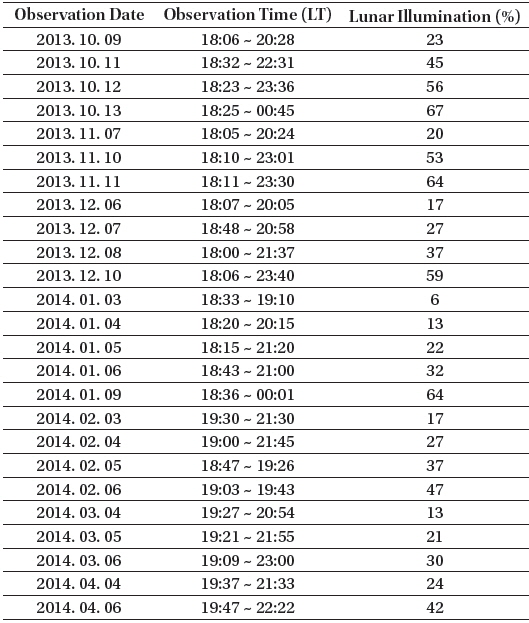
Observation Log
Frame images of the third candidate were analyzed with LiMovie; the relative brightness of the flash was obtained by summing up the pixel values within the red circle after removing the background value within blue circles in Fig. 4a. The peak brightness was 2434 in relative brightness units at frame number 15 within the red circle (293 pixels), and it is 0.66 times that of the surrounding area in the same number of pixels around the flash region marked by blue circles after subtracting the sky brightness per pixel of 5.3 in relative brightness units. . The absolute brightness of the dark side can be estimated from observation of a lunar eclipse by Jackson (1943), which set the total brightness of the eclipsed moon as magnitude ‘0’. This resulted in a brightness of 14.4 magnitude per pixel for our observed dark side of the moon (our pixel size 2.1″ × 2.3″ subtends 1/6 × 105 of the full moon), if the dark side is assumed to have the same brightness as the eclipsed moon. From this, the magnitude of the peak flash was estimated to be 8.7 ± 0.3 mag. The uncertainty of the estimated magnitude is due to uncertainty about the absolute magnitude of the lunar dark side, which may vary due to geological characteristics (bright highland vs. dark mare region). The estimated magnitude of the flash is consistent with the results of Oberst et al. (2012), who observed 115 impact flashes, mostly of magnitude 9–10, in the period of 2006–2009.
The light curve is presented in Fig. 4b with the relative brightness after subtracting the lunar background. The flash brightness (above background) lasted for five frames, and the total flash time may have been for 0.2 s if we include both starting and ending frames of the light curve. The time lapse of each frame is 0.0334 s and the flash peak occurred at 11:06:01.7816 UT. The light curve was asymmetric with respect to the peak, having a lower gradient in the trailing part than the leading part, which is consistent with that of an impact flash (Bouley et al. 2012). We reported this flash as an impact candidate to the lunar monitoring community operated by NASA/MEO, but it was suggested that it might have been a satellite reflection, based on the relatively symmetric shape of the light curve. At the time of the observed flash, we found no satellite near the direction of the moon. This was determined based on a public database of satellites, using the program Stellarium, which provides positions of 5138 satellites collected by a private company, CelesTrak (celestrak.com). Because the positions of all satellites, including especially defense missions, are not available to the public, it is hard to confirm or dismiss that there was no satellite in the direction of the impact flash candidate. Our observation certainly deserves at least as a strong candidate if not certainty as an impact flash, based on both brightness and asymmetric nature of the light curve.
During the LADEE mission campaign, there have been nine impact flashes confirmed by NASA/MSFC. The monitoring activity during this particular period resulted in many fewer lunar impact flashes than the frequency suggested by Oberst et al. (2012).
We have set up a video observation system for lunar impact flashes using the 16-inch educational telescope at Chungnam National University. During NASA’s LADEE mission (Oct. 2013 - Apr. 2014), we recorded 80 hours of video observations of the unilluminated part of the crescent moon in evening hours. We found a possible candidate of impact flash on Feb. 3, 2014 at the selenographic longitude of 2.1° and latitude of 25.4°. The flash lasted for 0.2 s and the light curve decreased more slowly after a peak brightness of 8.7 ± 0.3 mag. Based on a star-like distribution of pixel brightness and the asymmetric light curve, we propose that the observed flash was due to a meteoroid impact on the lunar surface, and was not just a disturbance caused by a cosmic ray hitting a CCD chip, or sunlight reflecting from a satellite in the line of sight. The ultimate verification of an impact flash requires simultaneous observation from at least two separate sites. We strongly recommend that other institutes and universities in Korea set up similar inexpensive monitoring systems using educational or amateur telescopes, and that we collaborate in the near future.

